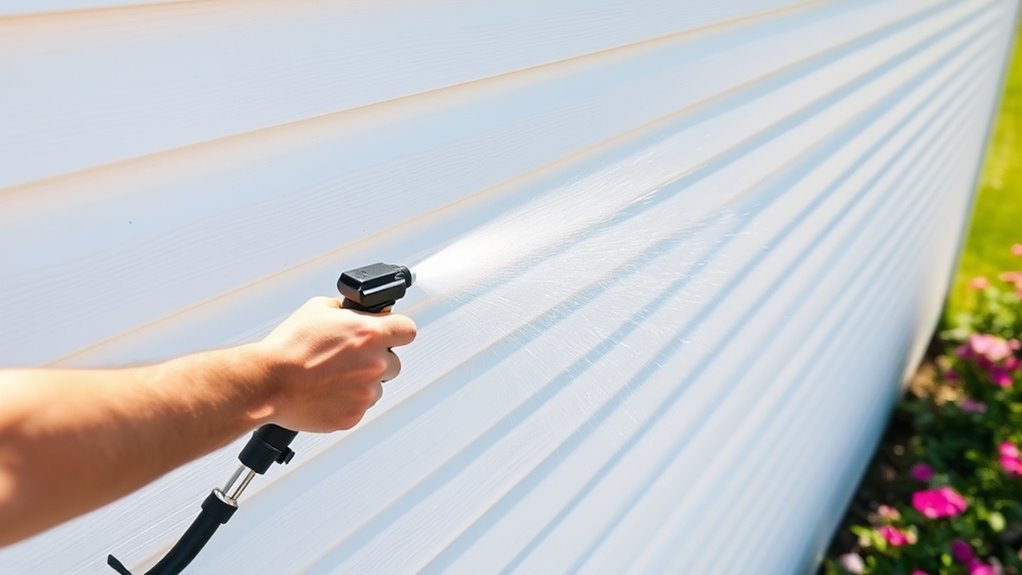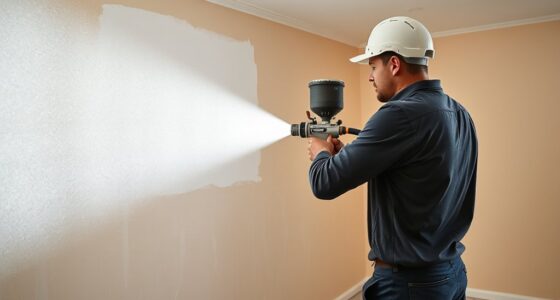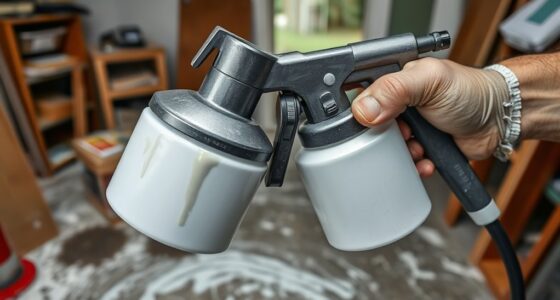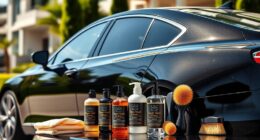Spraying vinyl siding works best when conditions are calm, dry, and mild, allowing for a smooth, even finish. Avoid spraying in windy, rainy, or very hot weather, as these can cause uneven coverage or paint failure. Proper surface preparation and selecting the right paint are essential for durability. Rushing the job can lead to poor results, so taking your time pays off. Keep exploring to discover more about perfecting your siding project.
Key Takeaways
- Spraying vinyl siding works best in calm, dry weather with moderate temperatures for even paint application and proper drying.
- Avoid spraying during windy, rainy, or extremely hot conditions to prevent overspray, poor adhesion, or premature peeling.
- Proper surface preparation, including cleaning and light sanding if needed, is essential before spraying to ensure durability.
- Use high-quality, exterior-grade acrylic or latex paints formulated for vinyl siding for optimal adhesion and longevity.
- Rushing the process or spraying in unsuitable conditions can lead to uneven coverage, paint failure, or environmental issues.
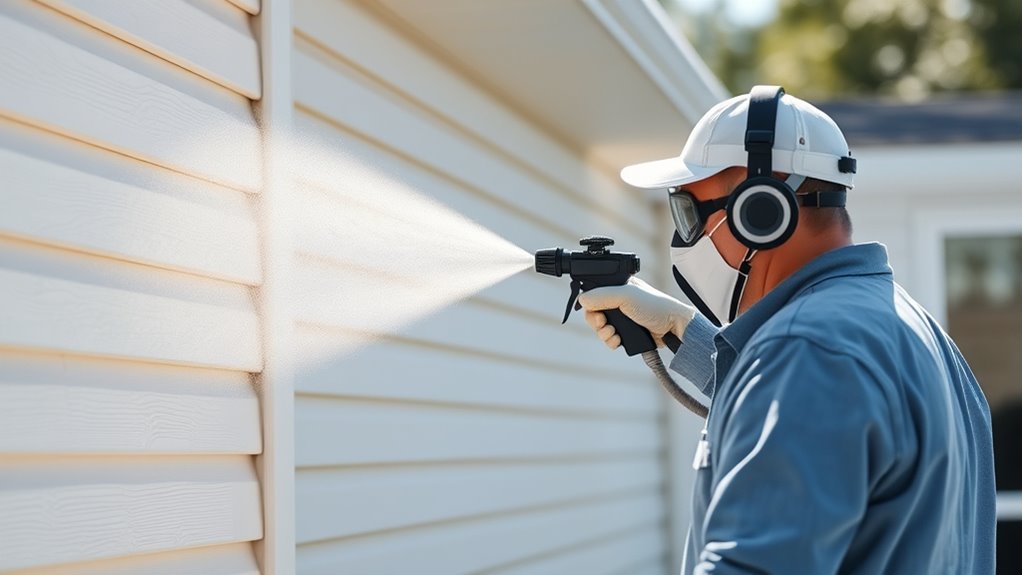
Have you ever wondered if spraying vinyl siding is a quick and effective way to refresh your home’s appearance? It can seem like an easy solution, but before you grab the spray gun, it’s imperative to understand the importance of proper paint preparation and environmental considerations. Good paint preparation ensures your siding will hold the new coat well, lasting longer and looking better. Start by thoroughly cleaning the surface to remove dirt, mold, or chalking paint. A pressure washer works great, but make sure to use a gentle setting to avoid damaging the vinyl. Once clean, inspect the siding for any cracks or damage and repair them before painting. Sanding isn’t usually necessary, but lightly scuffing glossy surfaces can help the paint adhere better. Using a high-quality, exterior-grade paint designed specifically for vinyl siding is essential. Avoid oil-based paints, as they tend to crack or peel over time. Instead, opt for acrylic or latex-based paints formulated for plastic surfaces. Proper paint preparation is critical because it directly affects the durability and appearance of your finished project. Additionally, choosing the right paint type can prevent issues like cracking or peeling, ensuring a longer-lasting finish.
Environmental considerations also play a significant role in determining whether spraying vinyl siding is the right choice. Weather conditions should be ideal—avoid painting on windy, rainy, or extremely hot days. High humidity can cause paint to bubble or not adhere properly, while direct sunlight can lead to uneven drying or premature peeling. Additionally, consider your surroundings. Spraying can produce overspray that drifts onto nearby plants, windows, or walkways, so cover these areas thoroughly. If you’re in a windy area, spraying might become messy and wasteful, making brushing or rolling a better option. Think about local regulations too; some communities have restrictions on outdoor painting or the use of certain chemicals that could impact your project. Proper paint preparation and environmental awareness are essential for achieving a professional-looking and durable finish.
Spraying vinyl siding can be quick, but rushing through the process often leads to poor results. Taking the time for proper paint preparation ensures your paint sticks well and lasts longer. Meanwhile, paying attention to environmental factors can prevent issues like overspray, uneven coverage, or paint failure. If you’re committed to a clean, professional-looking finish, these considerations are non-negotiable. Remember, a well-prepared surface and suitable weather conditions make all the difference in achieving a beautiful, durable update for your siding. When done correctly, spraying can be efficient, but ignoring these important steps might leave you with a mess or a job that needs fixing sooner than you’d like.
Frequently Asked Questions
How Long Does Spray Paint Last on Vinyl Siding?
You can expect spray paint on vinyl siding to last about 5 to 10 years, depending on environmental conditions. Good paint durability and weather resistance are key factors that influence longevity. To maximize lifespan, choose high-quality, exterior-grade paint designed for vinyl, and regularly clean and inspect your siding. Keep in mind that harsh weather, sun exposure, and dirt can reduce paint durability, so touch-ups may be needed over time.
Can Spraying Vinyl Siding Damage the Material?
Spraying vinyl siding can damage the material if you don’t consider surface texture and color matching. If you use too much spray, it can cause uneven patches or peeling, especially on textured surfaces. Poor color matching might make the siding look mismatched or faded over time. Always guarantee you choose the right spray paint designed for vinyl, and test on a small area first to prevent potential damage.
Is Special Equipment Needed for Spraying Vinyl Siding?
You’ll need special equipment for spraying vinyl siding, including a suitable spray gun type designed for smooth, even application. Equipment requirements include a high-pressure sprayer with adjustable settings to prevent damage, and a compatible nozzle for precise control. Using the right spray gun types guarantees an efficient, uniform coating without harming the siding. Always choose equipment specifically made for siding projects to get the best results and avoid unnecessary damage.
What Safety Precautions Should I Take When Spraying?
Think of spraying vinyl siding as charting a stormy sea—you need the right gear to stay safe. Always wear protective gear like goggles, gloves, and a mask to shield yourself from fumes and splashes. Make sure proper ventilation to prevent inhaling harmful vapors. Keep the area clear of pets and children, and work in good weather. These precautions help you steer safely through the process, minimizing health risks.
How Do I Prepare Vinyl Siding Before Spraying?
To prepare vinyl siding before spraying, start with thorough cleaning to remove dirt, mold, and debris, ensuring proper paint adhesion. Use a mild detergent or specialized cleaner, then rinse completely. Check paint compatibility to confirm the new coating will adhere well and last. Once cleaned and compatible, allow the siding to dry completely before spraying. Proper preparation guarantees a smooth, lasting finish and prevents future peeling or damage.
Conclusion
Spraying vinyl siding can be a quick fix, but it’s not always the best choice. When done right, it saves time and money—like painting over 1,000 square feet in just a few hours. However, remember that improper spraying can lead to uneven coverage or damage. So, weigh your options carefully. Sometimes, a professional touch guarantees your siding looks flawless and lasts longer. Make smart choices, and your home will shine for years to come.
Franz came aboard the Paint Sprayer Zone team with a background in both journalism and home renovation. His articulate writing style, combined with a passion for DIY projects, makes him an invaluable asset. Franz has a knack for breaking down technical jargon into easy-to-understand content, ensuring that even the most novice of readers can grasp the complexities of paint sprayers.
